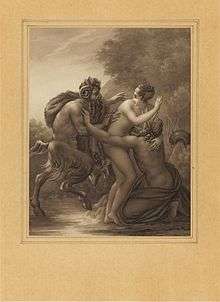Syrinx

| Greek deities series |
|---|
| Nymphs |
In classical mythology, Syrinx /ˈsɪrɪŋks/ (Greek Σύριγξ) was a nymph and a follower of Artemis, known for her chastity. Pursued by the amorous Greek god Pan, she ran to a river's edge and asked for assistance from the river nymphs. In answer, she was transformed into hollow water reeds that made a haunting sound when the god's frustrated breath blew across them. Pan cut the reeds to fashion the first set of pan pipes, which were thenceforth known as syrinx.[1] The word syringe was derived from this word.
In literature
The story of the syrinx is told in Achilles Tatius' Leukippe and Kleitophon where the heroine is subjected to a virginity test by entering a cave where Pan has left syrinx pipes that will sound a melody if she passes.[2] The story became popular among artists and writers in the 19th century. The Victorian artist and poet Thomas Woolner wrote Silenus, a long narrative poem about the myth, in which Syrinx becomes the lover of Silenus, but drowns when she attempts to escape rape by Pan. As a result of the crime, Pan is transmuted into a demon figure and Silenus becomes a drunkard.[3] Amy Clampitt's poem Syrinx refers to the myth by relating the whispering of the reeds to the difficulties of language.
Longus makes reference to Syrinx in his tale of "Daphnis and Chloe" in Book 2:34. Whilst the description of the tale here is modified to that of Ovid, it nevertheless incorporates Pan's desire to have her. Longus, however, makes no reference to Syrinx receiving aid from the Nymphs in his version, instead Syrinx hides from Pan in amongst some reeds and disappeared into the marsh. Upon realising what had happened to Syrinx, Pan created the first set of panpipes from the reeds she was transformed into, allowing her to be with him for the rest of his days.
The story was used as a central theme by Aifric Mac Aodha in her poetry collection Gabháil Syrinx.
Samuel R. Delany features an instrument called a syrynx in his science-fiction novel Nova.
Syrinx is the name of one of the main characters in the Night's Dawn Trilogy of space opera novels by British author Peter F. Hamilton. In the trilogy, Syrinx is a member of the transhumanist future society known as Edenism, and serves as the captain of the Oenone, a living starship.
James Merrill has a poem titled "Syrinx" in which several images from the mythological tale of the nymph Syrinx are incorporated.
In philosophy
In Dark Places of Wisdom, Peter Kingsley discusses in some detail the use of the word in Parmenides' poem and in association with the ancient practice of incubation[4]
In art

The Britiah Victorian artist Arthur Hacker depicted Syrinx in his 1892 nude. This painting in oil on canvas is currently on display in Manchester Art Gallery.
Sculptor Adolph Wolter was commissioned in 1973 to create a replacement for a stolen sculpture of Syrinx in Indianapolis, United States. This work was a replacement for a similar statue by Myra Reynolds Richards that had been stolen. The sculpture sits in University Park located in the city's Indiana World War Memorial Plaza.
In music
 |
|
| Problems playing this file? See media help. | |
Claude Debussy based his 1913 "Syrinx (La Flute De Pan)" on Pan's sadness over losing his love. The piece is still popular today; it was used as incidental music in the play Psyché by Gabriel Mourey.[5]
Maurice Ravel incorporated the character of the Syrinx into his ballet Daphnis et Chloé.
French Baroque composer Michel Pignolet de Montéclair composed "Pan et Syrinx", a cantata for voice and ensemble (No. 4 of Second livre de cantates).
Danish composer Carl Nielsen composed "Pan and Syrinx" (Pan og Syrinx), Op. 49, FS 87.
Canadian electronic progressive rock band Syrinx took their name from the legend.
Canadian progressive rock band Rush have a movement titled "The Temples of Syrinx" in their song "2112" on their album 2112. The song is about a dystopian futuristic society in which the arts, particularly music, have been suppressed by the Priests of the Temples of Syrinx.
Related to the Rush reference, Maryland based rockers Clutch mention "The Temples of Syrinx" in their song 10001110101 from their album Robot Hive/Exodus.[6]
References
- ↑ Ovid, Metamorphoses 1.689ff
- ↑ Reardon, B.P. "Leucippe and Clitophon." Trans. John J. Winkler Collected Ancient Greek Novels. Berkeley: University of California Press, 2008. 272-273.
- ↑ Thomas Woolner, Silenus, Macmillan, 1884.
- ↑ pages 101-135, but especially pages 116ff on "The Sound of Piping". Also pages 3–5 of Excerpts from In the Dark Places of Wisdom and Reality, by Peter Kingsley
- ↑ James McCalla, Twentieth-century Chamber Music: Routledge Studies in Musical Genres, Routledge, 2003, p.48
- ↑ http://pro-rock.com/index.cfm?page=discography&view=lyrics&albumid=14&lid=21
| Wikimedia Commons has media related to Syrinx. |
